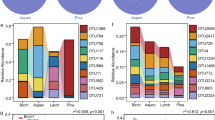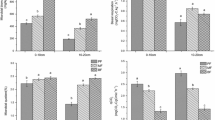Abstract
The composition and diversity of forest soil microbial communities may be affected by the composition of plant communities and characteristics of soils. The objective of our study was to compare microbial properties of soils under various types of temperate forests. The samples were taken from soil A horizons under dry and mesic pine forests, acidophilus and fertile beech forests, hornbeam and oak dominated deciduous forests and ash dominated riparian forest. The samples were analysed for pH and the contents of organic C and total N, P, K, Ca, Mg and Mn. Microbial analyses included determination of microbial biomass, basal respiration, community level physiological profiles (CLPPs) measured by MicroResp™ method and phospholipid fatty acid (PLFA) profiles. The soil microbial communities under the pine forests were lower, less active and exhibited different CLPPs and PLFA profiles than those under deciduous forests. The PLFA profiles and CLPPs were correlated to each other revealing that the observed different metabolic abilities under the pine and deciduous forest types resulted from differences in taxonomic composition of soil microbial communities. The CLPPs and PLFA profiles depended on soil texture and the contents of Corg, Nt, and Pt indicating that in the temperate forests the taxonomic and functional composition of soil microbial communities are shaped by both the soil properties and the vegetation. The functional diversity of soil microbial communities was not related to plant diversity indicating that in temperate forests the number of plant species has little effect on the ability of soil microorganisms to degrade different organic compounds.



Similar content being viewed by others
References
Anderson JPE, Domsch KH (1978) A physiological method for the quantitative measurement of microbial biomass in soils. Soil Biol Biochem 10:215–221
Attiwill PM, Adams MA (1993) Nutrient cycling in forests. New Phytol 124:561–582
Banning NC, Lalor BM, Cookson WR, Grigg AH, Murphy DV (2012) Analysis of soil microbial community level physiological profiles in native and post-mining rehabilitation forest: which substrates discriminate? Appl Soil Ecol 56:27–34
Bartelt-Ryser J, Joshi J, Schmid B, Brandl H, Balser T (2005) Soil feedbacks of plant diversity on soil microbial communities and subsequent plant growth. Persp Plant Ecol Evol Sys 7:27–49
Bauhus J, Paré D, Côté L (1998) Effects of tree, stand age and soil type on soil microbial biomass and its activity in a southern boreal forest. Soil Biol Biochem 30:1077–1089
Bauhus J, Khanna PK (1999) The significance of microbial biomass in forest soils. In: Rastin N, Bauhus J (eds) Going underground - ecological studies in Forest soils. Research Signpost, Trivandrum, India, pp. 77–110
Benjamini Y, Hochberg Y (1995) Controlling the false discovery rate: a practical and powerful approach to multiple testing. J R Statist Soc B 57:28–300
Bölscher T, Wadsö L, Börjeson G, Herrman AM (2016) Differences in substrate use efficiency: impacts of microbial community composition, land use management, and substrate complexity. Biol Fetil soils 52:547–559
Brackin R, Robinson N, Lakshmanan P, Schmidt S (2013) Microbial function in adjacent subtropical forest and agricultural soil. Soil Biol Biochem 57:68–77
Campbell CD, Chapman SJ, Cameron CM, Davidson M, Potts JM (2003) A rapid microtiter plate method to measure carbon dioxide evolved from carbon substrate amendments so as to determine the physiological profiles of soil microbial communities by using whole soil. Appl Environ Microbiol 69:3593–3599
Chen Y, Sun J, Xie F, Wang X, Cheng G, Lu X (2015) Litter chemical structure is more important than species richness in affecting soil carbon and nitrogen dynamics including gas emissions from an alpine soil. Biol Feril. Soils 51:791–800
Chodak M, Klimek B, Azarbad H, Jaźwa M (2015) Functional diversity of soil microbial communities under scots pine, Norway spruce, silver birch and mixed boreal forests. Pedobiologia – J soil. Ecol 58:81–88
Clarke KR (1993) Non-parametric multivariate analyses of changes in community structure. Aust J Ecol 18:117–143
Clarke KR, Green RH (1988) Statistical design and analysis for a “biological effects” study. Mar Ecol Prog Ser 46:213–226
De Deyn GB, Van der Putten WH (2005) Linking aboveground and belowground diversity. TRENDS. Ecol Evol 20:625–633
Demoling F, Figueroa D, Bååth E (2007) Comparison of factors limiting bacterial growth in different soils. Soil Biol Biochem 39:2485–2495
FAO (1998) World reference base for soil resources. Appendix 1. FAO, ISRIC and ISSS, Rome, Italy
Fischer J, Schauer F, Heipieper HJ (2010) The trans/cis ratio of unsaturated fatty acids is not applicable as biomarker for environmental stress in case of long-term contaminated habitats. Appl Microbiol. Biotech 87:365–371
Franzluebbers AJ, Haney F, Hons FM, Zuberer DA (1996) Active fractions of organic matter in soils with different texture. Soil Biol Biochem 28:1367–1372
Frostegård Å, Bååth E, Tunlid A (1993) Shifts in the structure of soil microbial communities in limed forests as revealed by phospholipid fatty acid analysis. Soil Biol Biochem 25:723–730
Frostegård Å, Bååth E (1996) The use of phospholipid fatty acid analysis to estimate bacterial and fungal biomass in soil. Biol Fertil Soils 22:59–65
Frostergård Å, Tunlid A, Bååth E (1996) Changes in microbial community structure during long-term incubation in two soils experimentally contaminated with metals. Soil Biol Biochem 28:55–63
Frostegård Å, Tunlid A, Bååth E (2011) Use and misuse of PLFA measurements in soils. Soil Biol Biochem 43:1–5
Garcia-Pausas J, Paterson E (2011) Microbial community abundance and structure are determinants of soil organic matter mineralisation in the presence of labile carbon. Soil Biol Biochem 43:1705–1713
Gartzia-Bengoetxea N, Kandeler E, de Arano IM, Arias-González A (2016) Soil microbial functional activity is governed by a combination of tree species composition and soil properties in temperate forests. Appl Soil Ecol 100:57–64
Hackl E, Pfeffer M, Donat C, Bachmann G, Zechmeister-Boltenstern S (2005) Composition of the microbial communities in the mineral soil under different types of natural forest. Soil Biol Biochem 37:661–671
Hamer U, Marschner B (2005) Priming effects in soils after combined and repeated substrate additions. Geoderma 128:38–51
Hammer Ø, Harper DAT, Ryan PD (2001) PAST: paleontological statistics software package for education and data analysis. Palaeontol Electron 4:9
Joergensen RG, Scheu S (1999) Response of soil microorganisms to the addition of carbon, nitrogen and phosphorous in a forest Rendzina. Soil Biol Biochem 31:859–866
Kanerva S, Kitunen V, Loponen J, Smolander A (2008) Phenolic compounds and terpenes in soil organic horizon layers under silver birch, Norway spruce and scots pine. Biol Fertil Soils 44:547–556
Kemmitt SJ, Wright D, Goulding KWT, Jones DL (2006) pH regulation of carbon and nitrogen dynamics in two agricultural soils. Soil Biol Biochem 38:898–911
Kiikkilä O, Kitunen V, Smolander A (2006) Dissolved soil organic matter from surface organic horizons under birch and conifers: degradation in relation to chemical characteristics. Soil Biol Biochem 38:737–746
Klimek B, Niklińska M, Jaźwa M, Chodak M, Tarasek A (2015) Application of the bait-lamina method to measure the feeding activity of soil fauna in temperate forests. Pol J Ecol 63:291–300
Kowalchuk GA, Buma DS, de Boer W, Klinkhamer PGL, van Veen JA (2002) Effects of above-ground plant species composition and diversity on the diversity of soil-borne microorganisms. Antonie Van Leeuwenhoek 81:509–520
Kuramae EE, Yergeau E, Wong LC, Pijl AS, van Veen JA, Kowalchuk GA (2012) Soil characteristics more strongly influence soil bacterial communities than land-use type. FEMS Microbiol Ecol 79:12–24
Ladygina N, Hedlund K (2010) Plant species influence microbial diversity and carbon allocation in the rhizosphere. Soil Biol Biochem 42:162–168
Lambers H, Chapin FS III, Pons TL (2008) Mineral nutrition. In: Lambers H, Chapin III FS, Pons TL (eds) Plant physiological ecology. Springer Science and Business Media, New York, pp. 255–320
Lauber CL, Hamady M, Knight R, Fierer N (2009) Pyrosequencing-based assessment of soil pH as a predictor of soil bacterial community structure at the continental scale. Appl Environ Microbiol 75:5111–5120
Leckie S (2005) Methods of microbial community profiling and their application to forest soils. For Ecol Manag 220:88–106
Menyailo OV, Hungate BA, Zech W (2002) Tree species mediated soil chemical changes in a Siberian artificial afforestation experiment. Plant Soil 242:171–182
Müller T, Höper H (2004) Soil organic matter turnover as a function of the soil clay content: consequences for model applications. Soil Biol Biochem 36:877–888
Nacke H, Thürmer A, Wollherr A, Will C, Hodac L, Herold N, Schöning I, Schrumpf M, Daniel R (2011) Pyrosequencing-based assessment of bacterial community structure along different management types in German forest and grassland soils. PLoS One 6(2):e17000. doi:10.1371/journalpone0017000
Nannipieri P, Ascher J, Ceccherini MT, Landi L, Pietramellara G, Renella G (2003) Microbial diversity and soil functions. Eur J Soil Sci 54:655–670
Nielsen UN, Ayres E, Wall DH, Bardgett RD (2011) Soil biodiversity and carbon cycling: a review and synthesis of studies examining diversity–function relationships. Eur J Soil Sci 62:105–116
Nohrstedt H-Ö (1988) Nitrogen fixation (C2H2-reduction) in birch litter. Scand J For Res 3:17–23
Orwin KH, Wardle DA, Greenfield LG (2006) Ecological consequences of carbon substrate identity and diversity in a laboratory study. Ecology 97:580–593
Ramsey PW, Rillig MC, Feris KP, Holben WE, Gannon JE (2006) Choice of methods for soil microbial community analysis: PLFA maximizes power compared to CLPP and PCR-based approaches. Pedobiologia 50:275–280
Rousk J, Brookes PC, Bååth E (2009) Contrasting soil pH effects on fungal and bacterial growth suggest functional redundancy in carbon mineralization. Appl Environ Microbiol 75:1589–1596
Rousk J, Bååth E, Brookes PC, Lauber CL, Lozupone C, Caporaso JG, Knight R, Fierer N (2010) Soil bacterial and fungal communities across a pH gradient in an arable soil. ISMEJ 4:1340–1351
Setälä H, Berg MP, Jones TH (2005) Trophic structure and functional redundancy in soil communities. In: Bardgett RD, Usher MB, Hopkins DW (eds) Biological diversity and function in soils. Cambridge University Press, Cambridge, pp. 236–249
Smolander A (1990) Frankia populations in soils under different tree species – with special emphasis on soils under Betula pendula. Plant Soil 121:1–10
Sradnick A, Murugan R, Oltmanns M, Raupp J, Joergensen RG (2013) Changes in functional diversity of the soil microbial community in a heterogeneous sandy soil after long-term fertilization with cattle manure and mineral fertilizer. Appl Soil Ecol 63:23–28
Stevenson FJ (1982) Humus chemistry: genesis, composition, reactions. John Wiley & Sons, New York
Thoms C, Gattinger A, Jacob M, Thomas FM, Gleixner G (2010) Direct and indirect effects of tree diversity drive soil microbial diversity in temperate deciduous forest. Soil Biol Biochem 42:1558–1565
Ushio M, Wagai R, Balser TC, Kitayama K (2008) Variations in the soil microbial community composition of a tropical montane forest ecosystem: does tree species matter? Soil Biol Biochem 40:2699–2702
Van der Maarel E (1979) Transformation of cover-abundance values in phytosociology and its effects on community similarity. Vegetatio 39:97–114
Yu J, Steinberger Y (2012) Soil microbial metabolic profiles in two geomorphological units in a semistable sand-dune ecosystem. Soil Biol Biochem 45:71–78
Zak JC, Willig MR, Moorhead DL, Wildman HD (1994) Functional diversity of microbial communities: a quantitative approach. Soil Biol Biochem 26:1101–1108
Zechmeister-Boltenstern S, Michel K, Pfeffer M (2011) Soil microbial community structure in European forests in relation to forest type and atmospheric nitrogen deposition. Plant Soil 343:37–50
Zelles L (1999) Identification of single cultured micro-organisms based on their whole-community fatty acid profiles, using an extended extraction procedure. Chemosphere 39:665–682
Acknowledgments
The study was supported financed by the Polish National Science Centre (project no: 00421/NZ8/2012/29) and by Jagiellonian University (subsidy WBiNoZ/INoS/DS759).
Author information
Authors and Affiliations
Corresponding author
Electronic supplementary material
ESM 1
(DOCX 34 kb)
Rights and permissions
About this article
Cite this article
Chodak, M., Klimek, B. & Niklińska, M. Composition and activity of soil microbial communities in different types of temperate forests. Biol Fertil Soils 52, 1093–1104 (2016). https://doi.org/10.1007/s00374-016-1144-2
Received:
Revised:
Accepted:
Published:
Issue Date:
DOI: https://doi.org/10.1007/s00374-016-1144-2




